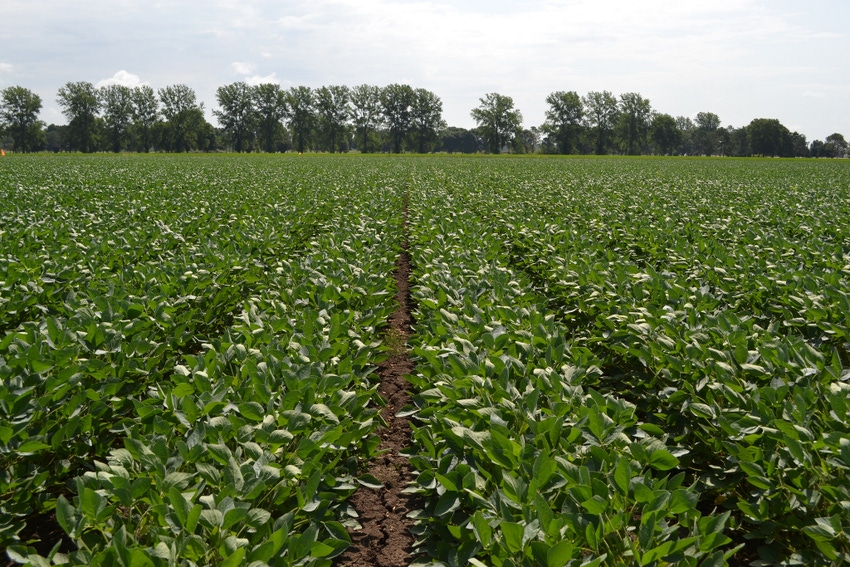Eastern Corn Belt budgets favor soybeans
Soybeans require significantly smaller upfront investment than corn.

Now that the holidays are behind us, agricultural economists Brent Gloy and David Widmarit say it is time to really start getting serious about 2017 planting decisions. While there are a variety of factors that play into farmers’ decisions, crop budgets certainly play a key role, they said.
“The analysis of this year’s crop budgets favor soybeans in many areas of the country. This appears to be particularly true in the eastern Corn Belt,” they said.
Purdue University prepares annual crop budgets that compare corn and soybean production in a variety of yield environments for the state of Indiana. The 2017 budgets show that farmers should once again expect negative net earnings for most cropping situations, which Gloy and Widmarit said is, unfortunately, not a new situation.
Data indicate that a farm with average quality farmland in Indiana can expect a loss of $166 per acre in 2017 (Figure). While this is a slight improvement from 2015 and 2016, the economists said it is still a rather large expected loss. Further, they said this will be the fourth consecutive year of large expected losses on most farms.

“While some farms may have more favorable cost structures than described in the budgets, it has clearly been a tough stretch and will make 2017 a very important year,” the economists said.
As farmers begin to make their planting decisions, Gloy and Widmarit said one of the key factors to consider is which crop makes the largest contribution to their fixed costs.
Soybeans are typically very competitive with corn in eastern Corn Belt locations such as Indiana, they added. In fact, corn contribution margins exceeded soybean contribution margins in only eight years from 2000 to 2017.
Most notably, the economists said corn was significantly more attractive in 2007, 2010, 2011, 2012 and 2013. In these years, corn contribution margin exceeded soybeans by a high of $87 per acre (2007) and a low of $38 (2010). From 2011 to 2013, the difference was a remarkably consistent $52 per acre.
On the other hand, when soybean contribution margins exceeded corn, the difference was not typically very large, they said. Prior to 2014, the most soybeans had exceeded corn was $27 in 2006.
Today, the difference is $64 per acre, the second-largest advantage for soybeans in the last 17 years. The only year with a larger budget period advantage was 2014, when the soybean advantage was $71 per acre, according to Gloy and Widmarit. “In general, it appears that in areas with budget conditions similar to Indiana, contribution margins strongly favor soybean production,” they said.
The obvious question that arises from the above analysis is whether there is a relationship between the level of contribution margins and planted acres of these crops, they said.
“At present, the budgeted contribution margins for Indiana show a clear advantage for soybeans over corn. The magnitude of the advantage is the second largest in the last 17 years," Gloy and Widmarit said. "While contribution margins are not perfect indicators of actual plantings, the data suggest that they often provide insights into actual planting decisions. Given the overall magnitude of the advantage, one would expect farmers with similar budget situations as those shown by Purdue budgets will be strongly consider soybeans in their rotation.”
However, they also stressed the importance other factors when thinking about planting decisions, one of which is the competitiveness of crops other than corn and soybeans. For example, they noted that part of the increase in corn acres last year came from farmers switching away from spring wheat.
“Additionally, the expected yields of soybeans compared to corn differs greatly throughout the country. In some areas budgets will look very different than those for Indiana,” they said.
Another factor that may come into play is the working capital and financial situation on farms, they said, explaining, “Soybeans require a significantly smaller upfront investment than corn. Given the previous three years of losses, one might expect that this will play into some farmer’s thinking.”
Finally, they said farmers must consider how many acres can actually be planted to soybeans, even when budgets favor the crop. The lowest ratio of corn to soybean plantings in Indiana was 93%, and soybeans exceeded corn plantings by only 400,000 acres that year.
About the Author(s)
You May Also Like

.png?width=300&auto=webp&quality=80&disable=upscale)

